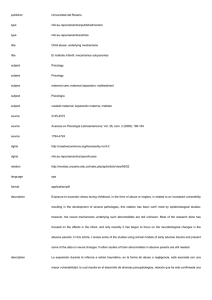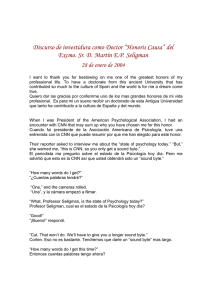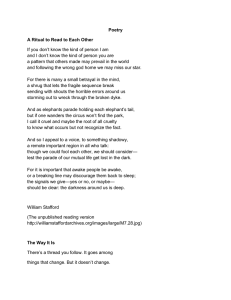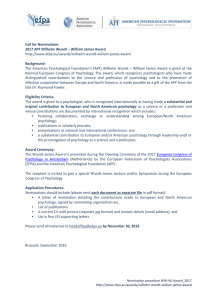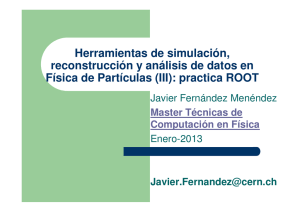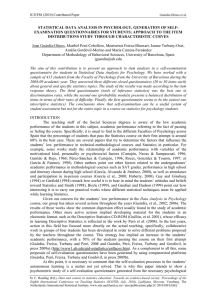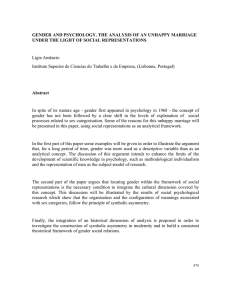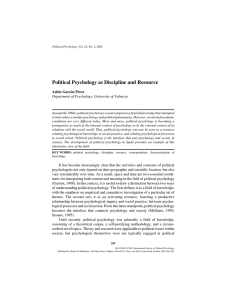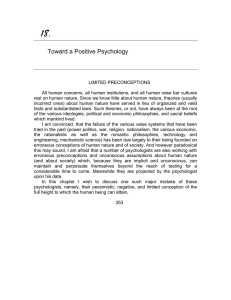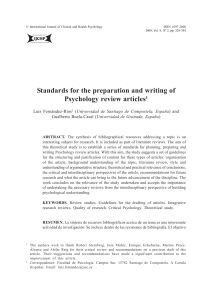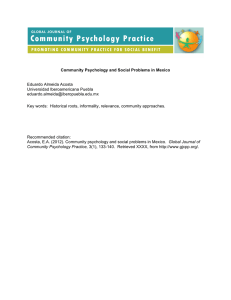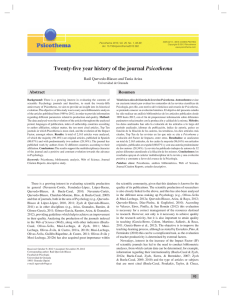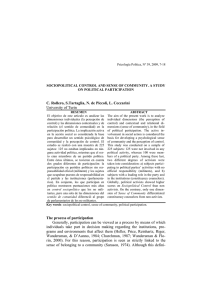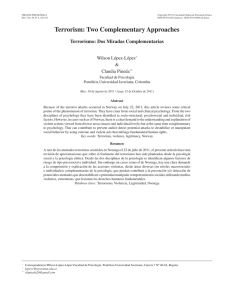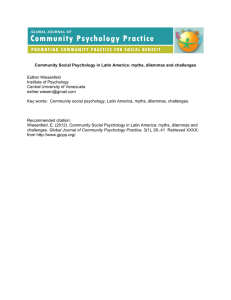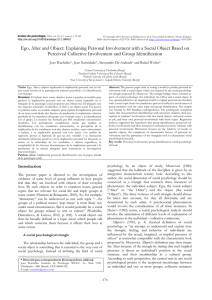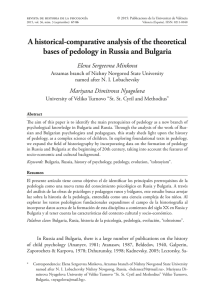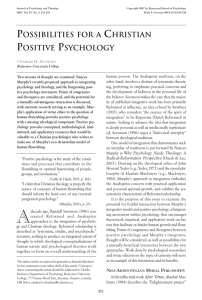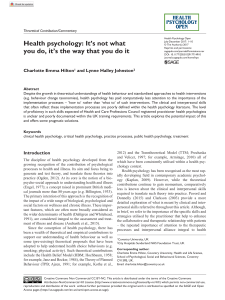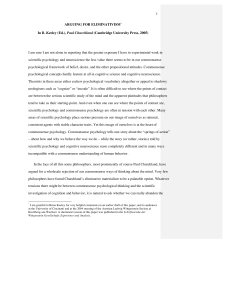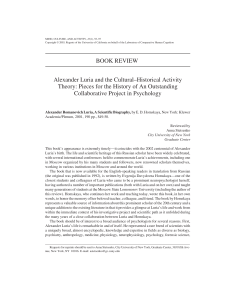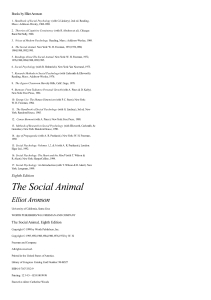KNOWLEDGE OF THE BEHAVIORS AND CONSEQUENCES OF
Anuncio
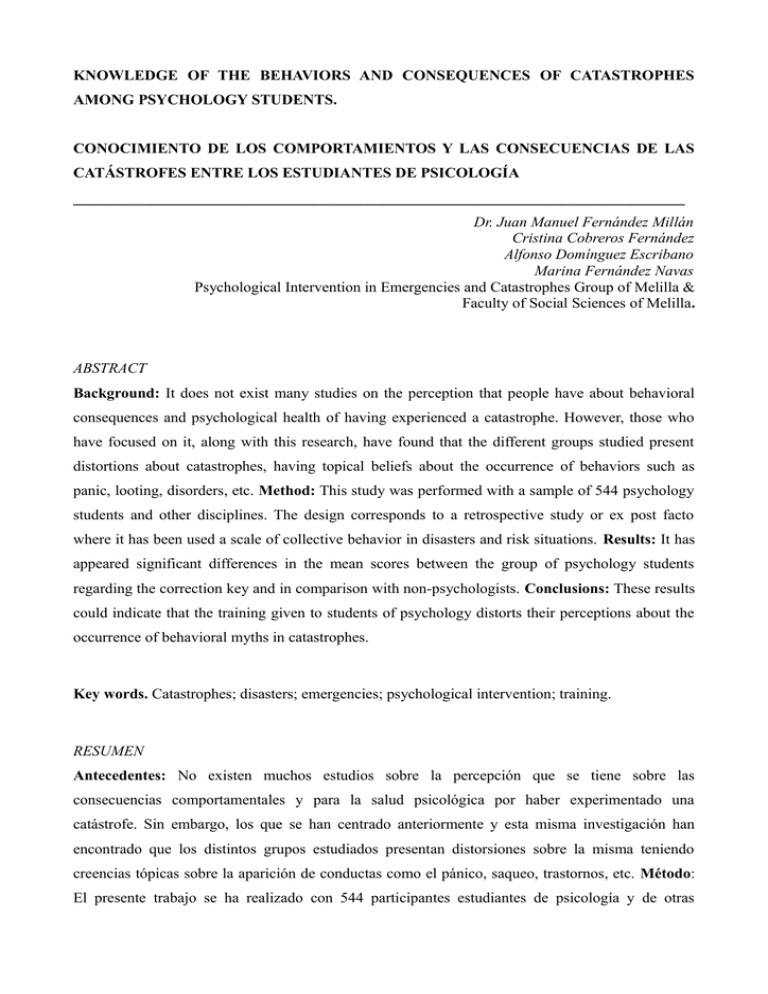
KNOWLEDGE OF THE BEHAVIORS AND CONSEQUENCES OF CATASTROPHES AMONG PSYCHOLOGY STUDENTS. CONOCIMIENTO DE LOS COMPORTAMIENTOS Y LAS CONSECUENCIAS DE LAS CATÁSTROFES ENTRE LOS ESTUDIANTES DE PSICOLOGÍA _______________________________________________________________________________ Dr. Juan Manuel Fernández Millán Cristina Cobreros Fernández Alfonso Domínguez Escribano Marina Fernández Navas Psychological Intervention in Emergencies and Catastrophes Group of Melilla & Faculty of Social Sciences of Melilla. ABSTRACT Background: It does not exist many studies on the perception that people have about behavioral consequences and psychological health of having experienced a catastrophe. However, those who have focused on it, along with this research, have found that the different groups studied present distortions about catastrophes, having topical beliefs about the occurrence of behaviors such as panic, looting, disorders, etc. Method: This study was performed with a sample of 544 psychology students and other disciplines. The design corresponds to a retrospective study or ex post facto where it has been used a scale of collective behavior in disasters and risk situations. Results: It has appeared significant differences in the mean scores between the group of psychology students regarding the correction key and in comparison with non-psychologists. Conclusions: These results could indicate that the training given to students of psychology distorts their perceptions about the occurrence of behavioral myths in catastrophes. Key words. Catastrophes; disasters; emergencies; psychological intervention; training. RESUMEN Antecedentes: No existen muchos estudios sobre la percepción que se tiene sobre las consecuencias comportamentales y para la salud psicológica por haber experimentado una catástrofe. Sin embargo, los que se han centrado anteriormente y esta misma investigación han encontrado que los distintos grupos estudiados presentan distorsiones sobre la misma teniendo creencias tópicas sobre la aparición de conductas como el pánico, saqueo, trastornos, etc. Método: El presente trabajo se ha realizado con 544 participantes estudiantes de psicología y de otras carreras. El diseño corresponde a un estudio retrospectivo o ex post facto en el que se ha utilizado una escala sobre comportamiento colectivo ante catástrofes y situaciones de riesgo Resultados: Han aparecido diferencias significativas de las puntuaciones medias del grupo de psicólogos respecto a las claves de corrección y el grupo de no-psicólogos. Conclusiones: Estos resultados podrían indicar que la formación que se les da a los alumnos de psicología distorsiona la percepción que tienen sobre la ocurrencia de conductas-mito en las catástrofes. Palabras claves: Catástrofes; desastres; emergencias; intervención psicológica; formación. 1. INTRODUCTION The study and psychological intervention in disasters and emergencies is a relatively new field of psychology that aims, at short and medium term, to alleviate the suffering of the people involved and their families, to accelerate the natural healing process and to prevent the onset and maintenance of delayed psychological sequelae (Fernández-Millán, 2014; Marcuello 2006). Terrorist events, natural disasters, large scale accidents, among others, and their consequences, such as post-traumatic stress, show the need of study and intervention in this branch of psychology (Guerra, Cumsille & Martínez, 2014; Leiva-Bianchi, 2011). Situations like the flood of Biescas (Spain), the 11th September 2001 at the Twin Towers in New York, the 11th March 2004 in Madrid, Lorca (Spain) earthquake in May 2011, the Fukushima nuclear accident 2011 or tragedies such as the Madrid Arena in November 2012, are those that have sensitized the scientific community, producing an increase in the number of relevant publications in Hispanic literature (e.g.: Andrés & De Nicolás, 2000; Baloian, Chia, Cornejo & Paverini, 2007; Fernández-Millán, 2005; Figueroa, Marín & González 2010; Sánchez & Amor 2002) and internationally (Sattler et al., 2014). Parallel have emerged organizations and professionals specialized in the psychological care in emergencies. Some examples are the creation in Spain of groups called GIPECS (Psychological Intervention in Emergencies and Catastrophes Group) within Spanish Psychological Associations, the emergence of specialized Masters, such as Master in Counseling and Intervention in Emergencies and Catastrophes from the University of Malaga, and the inclusion of courses on this subject in Grades of Psychology. But despite the increase in the study of psychology on disaster intervention and the associated symptoms (Diehle, Schmitt, Daams, Boer & Lindauer, 2014; Newman et al.2014; Spence et al., 2014), there are still many myths and misconceptions circulating about the consequences and psychological and behavioral effects of direct and indirect participants, in the population as a whole and in the specific professional contexts. We are all exposed to media sensationalism that causes such situations. The media inform us of the facts, but also the rumors and suspicions, carefully selecting the images, audios and shocking statements, which skews and distorts perception and impact of the event. Studies such as McCombs (1996) conclude that the press has huge effects when creating opinions and almost none when it comes to make us think. Goiricelaya (1998) notes, among the problems that mass media cause or exacerbate, they perpetuate the beliefs and behaviors of people such as panic, total helplessness, dependence on foreign aid or looting. There are other sources of specific bias and distortions of the professionals working and studying on the field of psychology. The very fact of studying or dealing exclusively with psychopathologies present in these events or the negative consequences of experiencing a catastrophe can foster the belief that their incidence rate is much higher. The poor training regarding empowerment, resilience and personal growth developed by those involved, normally goes unnoticed, leaving the knowledge given to us by positive psychology in the background. A proof of this, it is the limited literature in this regard, among which we find research articles such as Twigg (2007), Uriarte (2010) and Páez, Fernández and Martín Beristain (2001). The latter suggests that: "In many disasters and risk situations appropriate collective behaviors are observed (as the order in the evacuation of a population at risk), which will allow facing the spread of rumors or danger and the rational organization of resources "(p. 2). In relation to these distortions, Paez, Fernández & Martín Beristain (2001) considere as myths the behaviors such as looting or panic, claiming that the latter, although only occurs in 10% of the cases, is perceived by most experts in a 50-75% of the cases. Furthermore, these authors argue that many of these behaviors are fostered by normalization errors due to management authorities, not by the disaster itself. Fernández (2008) performed a study on the various myths and beliefs concerning catastrophes using a scale of collective behavior. After analyzing the results of its application, they concluded that panic, looting and increased psychological symptoms after a disaster are seen well above the rate of incidence. It exists more literature supporting these results (Belmar, Chia, Cornejo y Paverini, 2012; Valero, 2011). Based on the above, this study questions whether specific training in psychological intervention in emergency situations makes these professionals more realistic about the consequences of having a disaster or whether they are also victims of media, professional or other bias. To this end, it has been conducted a literature review and Páez, Martín Beristain and Fernández's questionnaire (2001) was found as a proper instrument. The main objective of the study is to determine the degree of "realistic" knowledge that psychology students have about the appearance of "topics" behaviors in disasters. This is to say, to what extent the training they have received will let them know more accurately about the emergence of behaviors associated with disasters. We propose the following hypotheses: First. The measures of the items from the group of psychology students (or group of psychologists) obtained in this study will differ significantly from the correction key. Second. The group of psychologists will have scores more "catastrophic" than the group of "non-psychologists". We mean, for those items that represent maladaptive behaviors, psychologists will present scores more extreme and far from the correction key (absence or minimal maladaptive behaviors). Third. The variable “Specific training in the area of management and intervention in disasters” will improve the perception (a more accurate knowledge) of behaviors that appear in disasters and the consequences arising therefrom. 2. METHOD. 2.1 Sample The study involved a total of 544 subjects (431 psychology students or master students and 113 university students of other degrees) aged between 20 and 49 years (Mean= 22.35, SD = 3.32), 83% women. Exactly, 84,2% women in the group of psychology students and 79,6% women in the group of other students. 2.2 Design The design of this research belongs to the category of retrospective or ex post facto surveys (Ato, López and Benavente, 2013), seeking to analyze and compare the relationship between variables through the differences between two groups of individuals, according to differential situations created by nature or society. 2.3 Tools To obtain the assumptions that participants have about the occurrence of certain behaviors resulting from a disaster, it has been used the Scale on collective behavior (Fernández, 2008). See Appendix. 2.4 Procedure Information was collected through the above scale of students from different Spanish Universities (Granada, Santiago, Valencia, Associate Center to the UNED, Cádiz and Málaga). 2.5 Statistical analysis A hypothesis contrast has been carried out using the parametric one-sample T-Test in order to determine whether the means of each group (psychologists and non-psychologists) differ significantly from the correction key. Also, the means of both groups have been compared by independent samples T-Test in order to discover which group has a higher catastrophic perception and how the variable “Specific training” influences on the perception of the behaviors and its consequences. The estimation of the effect size was obtained through different procedures (Formula's Cohen and partial Eta squared) based on statistical characteristics. The computer program SPSS, version 12.0, has been used to perform the statistical analysis of the data. 3. RESULTS. 3.1 1st Hypothesis Taking as a sample the group of psychologists (n = 431) we proceede with a means comparison using one-sample T test since, according to Pardo and Ruiz (2005, p. 319), from 20 to 30 subjects the setting of the T-Test to the student-t distribution is good enough even with populations far from normal in origin. In this way, we appreciate (see Table 1) that the means obtained by the group of psychologists differ significantly (p <0.05) from the key correction on all items except item 12, where it matches the key correction. Besides, these differences have a large effect size (d> 0.80, Cohen, 1988) in almost all the items. Therefore, we can say that there are significant differences between the scores obtained by psychologists and key correction confirming the first hypothesis (See Table 1) . 3.2 2nd Hypothesis Taking each of the groups as independent samples and proceeding through parametric statistics such as the independent samples T-Test, it is obtained statistically significant differences (p <0.05) between the group of psychologists and non-psychologists in the items 1, 2, 3, 4, 6, 7, 9, 10 and 14, where psychologists exhibits higher means in items 1, 2, 4, 6 and 7 (see Table 2) . However, it should be noted that, in spite of these statistically significant differences, the values of effect size do not exceed 0.1 (see Table 2) and therefore, differences are insignificant. (See Table 2) According to the results, the second hypothesis is confirmed, this is, the group of psychologists has more "catastrophic" answers than the group of non-psychologists. 3.3 3rd Hypothesis Similarly, and in order to complement the statistical analysis we proceeded with the study of the influence of specific training variable with significant differences in items 5 (p = 0.046) and 8 (p = 0.035). In spite of these significant differences in both items, the training variable only involves a more realistic perception in item 8, as the mean of the sample with training goes far away from the correction key ( sample without training ( =2,83>1) though in a lesser extent than the form =3,04>1) (see Table 3). nform These results do not support the hypothesis that the variable training will involve a more realistic perception of the behaviors associated to catastrophes and the consequences arising therefrom (See Table 3) 4. DISCUSSION AND CONCLUSIONS. Data from our study indicates that college students of psychology degree have significantly higher scores on most items from Behaviors in Disasters and Risk Situations Scale than other college students, confirming the first two hypotheses of the study. These results are consistent with those obtained in previous studies (Fernández, 2008; Páez, Fernández and Martín Beristain, 2001). (See Table 4). The relevance of these results stems from the fact that the planning and subsequent actions are based on the expected events (individual behaviors, appearance of disorders and collective reactions). Therefore, any distortion about what is supposed to be "normal" to occur, will affect the allocation of resources and the way in which we treat people involved. (See Figure 1. Comparison of the mean scores obtained for the various samples and the correction key). The comparison between the different samples and the correction key (see Table 4 and Figure 1) shows that, in fact, psychology students have higher and farther means from the correction key than the other groups in items 2, 6, 7, 11 and 13 and pretty high and far (although not the most) in item 8. A review about the concepts present in these items shows that those concepts (panic, onset of symptoms, fatalism and vulnerability), when they score high, mean a more negative and maladaptive view of the affected population. However, currently we do not have sufficient scientific data to determine whether these findings are due to: 1) that the current curriculum in our universities or how they approach to traumatic events (such as accidents, emergencies, disasters ...) promotes cognitive distortions or does not correct the ideas created about some cognitive/behavioral myths (topics) among the students on this subject. Therefore, instead of providing the students with a closer view to the actual occurrence, the contents taught and the way they are taught cause a sensitization to the issue that results in an overstatement of the probability of occurrence of maladaptive behaviors such as panic or looting; 2) than students psychology may have a higher incidence of emotional disorders such as anxiety and depression and this affects in the perception of symptoms around them (Thomas, Caputi & Wilson, 2014); etc. Furthermore, data related to the third hypothesis (see Table 3) indicates that specific training on psychology applied to situations of disasters (Masters or courses) does not produce significant changes. This is important because it could mean that not only the incorporation of theoretical and practical material in the training of future psychologists must be effective, but also how to approach and teach these contents, fleeing from fatalism and psychologisms. Taking into account the limitations of our study, future research should explore in more depth: 1) the study of the relationship between curriculum and cognitive distortions in this area, 2) the study of the differences in age and sex, 3) the investigation of the incidence of emotional disorders in the university population and their effects, 4) a psychometric validation of the scale (reliability, validity, etc.). Finally, it might also be interesting to study the effect of training in the GIPECs from the various Psychological Associations in Spain to find out if this training is more appropriate in the sense of providing a more realistic view of the individual and group psychological consequences on catastrophes. 5. REFERENCES. Andres, R., & De Nicolás, L. (2000). Intervención psicológica en situaciones de emergencia y desastres. Servicio de Publicaciones del Gobierno Vasco. Ato, M., López, J. J. & Benavente, A. (2013). Un sistema de clasificación de los diseños de investigación en psicología. Anales de Psicología, 29, 3, 1038-1059. http://dx.doi.org/10.6018/analesps.29.3.178511 Baloian, I., Chia, E., Cornejo, C. & Paverini, C. (2007). Intervención psicosocial en situaciones de emergencia y desastres: guía para el primer apoyo psicológico. Chile: ONEMI. Recuperado el 10 de junio de 2014, del sitio web diversidadmurciaeduca: http://diversidad.murciaeduca.es/orientamur2/gestion/documentos/2-intervencion_psicosocial.pdf Belmar, D., Bondes, M., Levi, Y., Moreno, J. P. & Rehbein, L. (2012). Estrés Post-Traumático. Locus de control y fatalismo en adultos afectados por el terremoto del 27 de Febrero en la ciudad de Angol. Salud y Sociedad: Investigaciones en psicología de la salud y psicología social, 3 (1), 1018. Cohen, J. (1988). Statistical power analysis for the behavioral sciences. (2ª ed). Hillsdale, N.J.: Erlbaum. Colexio Oficial de Psicoloxía de Galicia (2014). Circular informativa del Colexio Oficial de Psicoloxía de Galicia. Santiago de Compostela: COP-Galicia. Diehle, J., Schmitt, K., Daams J. G., Boer, F. & Lindauer, R. J. (2014). Effects of psychotherapy on trauma-related cognitions in posttraumatic stress disorder: A meta-analysis. Journal of Traumatic Stress, 27(3), 257-264. Doi. 10.1002/jts.21924 Fernández, I. (2008) Cuaderno de prácticas de psicología social y comunitaria. Madrid: Sanz y Torres Fernández-Millán, J. M. (2005). Apoyo psicológico en situaciones de emergencia. (2ª ed.). Madrid: Pirámide. Fernández-Millán, J. M. (2014). Gestión e intervención psicológica en emergencias y catástrofes. Madrid: Pirámide. Figueroa, R. A., Marín, H., y González, M. (2010). Apoyo psicológico en desastres: Propuesta de un modelo de atención basado en revisiones sistemáticas y metaanálisis. Revista médica de Chile, 138(2), 143-151. Goiricelaya, E. (1998). Desastres y medios de comunicación. Gallarta: Emergencia 112. Guerra, C., Cumsille, P. & Martínez, M. L. (2014). Síntomas de estrés postraumático en adolescentes expuestos a un terremoto: asociación con autoeficacia, magnitud percibida y miedo. International Journal of Clinical and Health Psychology, 14(3), 202-207. Leiva-Bianchi, M. (2011). The relevase and prevalence of post-traumatic stress after an earthquake: public health problema in Constitution, Chile. Revista de Salud Pública, 13(4), 551-559. Marcuello, A. (2006). Intervención Psicológica Inmediata en Catástrofes, Revista Psicología Online. Recuperado el 10 de junio de 2014, de http://www.psicologia- online.com/articulos/2006/psicologica_catastrofes.shtml McCombs, M. (1996). Influencia de las noticias sobre nuestra imagen del mundo. En J. Bryant y D. Zillmann, (Eds.). Los efectos de los medios de comunicación. Investigaciones y teorías (pp.13-34). Barcelona: Paidós Newman, E., Pfefferbaum, B., Kirlic, N., Tett, R., Nelson, S. & Liles, B. (2014). Meta-analytic review of psychological interventions for children survivors of natural and man-made disasters. Current psychiatry reports, 16(9), 1-10. Páez, D., Fernández, I., & Martín Beristain, C. M. (2001). Catástrofes, traumas y conductas colectivas: procesos y efectos culturales. En C. San Juan (Ed..). Catástrofes y ayuda de emergencia. (pp. 85148). Barcelona: Icaria. Pardo, A. & Ruíz, M. A. (2005). Análisis de dato con SPSS 13 Base. Madrid:McGrawHill. Sánchez, J. & Amor, J. (2002). Intervención psicológica en las catástrofes. Síntesis. Recuperado el 10 de junio de 2014, del sitio web diversidadmurciaeduca: http://diversidad.murciaeduca.es/orientamur2/gestion/documentos/2-intervencion_psicosocial.pdf Spence, J., Titov, N., Johnston, L., Jones, M. P., Dear, B. F. & Solley, K. (2014). Internet-basedtraumafocused cognitive behavioural therapy for PTSD with and without exposure components: A randomized controlled trial. Journal of Afective Disorders, 162, 73-80. Thomas, S. J., Caputi, P. & Wilson, C. J. (2014). Specific attitudes with predict psychology students ´intentions to seek help for psychological distress. Journal of Clinical Psychology, 70(3), 273-282. Twigg, J. (2007). Características de una comunidad resilliente ante los desastres. Recuperado el 10 de junio de 2014, del sitio web escuela de administración pública del distrito federal http://www.eap.df.gob.mx/sii/images/11.%20M1%20UA2red.pdf Uriarte, J. (2010). La resiliencia comunitaria en situaciones catastrófica y de emergencia. International Journal of Developmental and Educational Psychology INFAD Revista de Psicología, 1, 687-693 Valero, M. (2011). Reacciones de adolescentes ante desastres y emergencias: Aspectos psicosociales derivados del 11 de marzo. (Tesis doctoral). Universitat Jaume I. Castellón. Recuperado de http://www.tdr.cesca.es/handle/10803/41559 13 Table 1. Contrast of a single mean between the correction key of the items and the group of psychologists. Confidence interval 95% Correction Key Mean Mean difference Standard derivation Std. Error Mean t Degrees of freedom Sig. Effect size Item 1 4 2,32 -1,68 0,91 0,04 -38,34 430 0,00 1,84 Lower -1,77 Upper -1,59 Item 2 Item 3 Item 4 Item 5 Item 6 Item 7 Item 8 Item 9 Item 10 Item 11 Item 12 Item 13 Item 14 1 1 3,5 3,5 1 1 1 3 2 1 3 1 1 3,36 2,04 3,60 2,72 3,04 2,78 2,98 2,66 2,69 2,90 3,00 2,54 2,45 2,36 1,04 0,10 -0,78 2,04 1,78 1,98 -0,34 0,69 1,90 0,00 1,54 1,45 0,80 0,91 0,67 0,86 0,83 0,80 0,85 1,07 0,82 0,78 0,80 0,85 0,83 0,04 0,04 0,03 0,04 0,04 0,04 0,04 0,05 0,03 0,04 0,04 0,04 0,04 61,01 23,55 2,98 -18,67 50,96 46,23 48,46 -6,50 17,42 50,33 0,06 37,73 36,26 430 430 430 430 430 430 430 430 430 430 430 430 430 0,00 0,00 0,00 0,00 0,00 0,00 0,00 0,00 0,00 0,00 0,95 0,00 0,00 2,94 1,13 0,14 0,89 2,45 2,23 2,33 0,31 0,83 2,42 0,00 1,82 1,75 2,28 0,95 0,03 -0,86 1,97 1,70 1,90 -0,44 0,61 1,82 -0,07 1,46 1,37 2,44 1,12 0,16 -0,69 2,12 1,86 2,06 -0,23 0,77 1,97 0,08 1,62 1,52 14 Table 2. Independent samples T-test to compare means between the group of psychologists (Psy.) and non-psychologists (Others). Item 1 Item 2 Item 3 Item 4 Item 6 Item 7 Item 9 Item 10 Item 14 Group N Mean Standard derivatio n Psy. Others Psy. Others Psy. Others Psy. Others Psy. Others 431 113 431 113 413 113 431 113 431 113 2,32 2,06 3,36 2,95 2,04 2,23 3,60 3,16 3,04 2,83 0,91 0,90 0,80 0,89 0,91 0,94 0,67 0,91 0,83 0,85 0,04 0,08 0,04 0,08 0,04 0,09 0,03 0,09 0,04 0,08 Psy. Others Psy. Others Psy. Others Psy. Others 431 113 431 113 431 113 431 113 2,78 2,42 2,66 2,98 2,69 2,90 2,45 2,67 0,80 0,92 1,07 0,94 0,82 0,86 0,83 0,84 0,04 0,09 0,05 0,09 0,03 0,08 0,04 0,08 Std. Error Mean Levene's Test for Equality of Variances t Degrees of freedom Sig. Means difference Std. Error Difference Effect size Confidence interval 95% F 1,38 Sig. 0,24 Lower Upper -2,69 542 0,007 -0,26 0,10 0,01 -0,45 -0,07 0,61 0,44 4,75 542 0,000 -0,41 0,09 0,04 -0,58 -0,24 1,07 0,30 1,99 542 0,047 0,19 0,10 0,01 0,00 0,38 22,7 0,00 4,77 145,32 0,000 -0,44 0,09 0,06 -0,62 -0,26 1,17 0,28 2,40 542 0,017 -0,21 0,09 0,01 -0,39 -0,04 10,1 0,00 3,83 158,64 0,000 -0,36 0,09 0,03 -0,55 -0,18 16,6 0,00 3,12 196,75 0,002 0,32 0,10 0,01 0,12 0,52 0,84 0,36 2,41 542 0,016 0,21 0,09 0,01 0,04 0,39 0,00 0,99 2,59 542 0,010 0,23 0,09 0,01 0,05 0,40 15 Table 3. Difference in the total sample taking as a variable the specific training (Trai,). N Mean Standard derivation Std. Error Mean Item 5 Training NoTrai. 89 455 2,57 2,78 0,85 0,90 0,09 0,04 Item 8 Training NoTrai. 89 113 2,83 3,04 0,82 0,85 0,09 0,04 Test de Levence F Sig. 0,24 0,63 0,00 0,99 Confidence interval 95% Sig. Means difference Std. Error Difference Effect size Lower Upper 2,00 Degrees of freedom 542 0,046 0,21 0,10 0,01 0,00 0,41 2,11 542 0,035 0,21 0,10 0,01 0,01 0,40 t Table 4. Mean scores obtained in this and other works. Item Correction key (Fernández, 2008) Psychology students Other students Páez, Fernández and Martín Beristain (2001) Fernández (2008) 1 2 3 4 5 6 7 8 9 10 11 12 13 14 4 2,32 1,91 1 3,36 2,75 1 2,04 2,35 3,5 3,60 2,93 3,5 2,72 2,73 1 3,04 2,67 1 2,78 2,22 1 2,98 3,09 3 2,66 3,05 2 2,69 2,95 1 2,90 2,91 3 3,00 2,75 1 2,54 2,55 1 2,45 2,69 2,55 2,5 2,48 2,24 1,64 1,52 2,83 2,66 2,41 2,93 2,29 2,29 2,55 2,21 2,42 2,45 2,02 2,48 2,57 1,98 2,47 2,57 2,01 2,36 2,53 1,95 2,82 2,71 Figure 1. Comparison of the mean scores obtained for the various samples and the correction key. APPENDIX Behaviors in Disasters and Risk Situations Scale. ESCALA DE COMPORTAMIENTO ANTE CATÁSTROFES Y SITUACIONES DE RIESGO (Fuente: Adaptado de Páez, Fernández y Martín Beristain, 2001) Sexo: _______________________________Edad:_________________________________ ¿Has recibido en tu carrera formación específica sobre catástrofes?_____________________ ¿Has vivido o presenciado alguna catástrofe? ¿De qué tipo?_______________________ ¿Algún familiar o conocido suyo ha sufrido una catástrofe? ¿Quién?_____________________ A continuación se exponen una serie de hechos que ocurren con cierta frecuencia durante las catástrofes y/o situaciones de riesgo, en las cuales se ven implicadas un número elevado de personas. Por favor, le solicitamos que conteste, en su opinión teniendo en cuenta la siguiente escala: o Si cree que ocurre poco o nada (0-10%) marca un 1 o Si cree que ocurre con cierta frecuencia, pero no más de la mitad de las veces (11-49%) marca un 2. o Si cree que ocurre muy frecuentemente (50-75%) marca un 3. o Y si cree que es mayoritario (76-100%) marca un 4. 1. 2. 3. 4. 5. 6. 7. 8. 9. 10. 11. 12. 13. 14. Negar el peligro, ignorarlo o minimizarlo en la fase previa Escenas de pánico Escenas de saqueo Escenas de miedo Las autoridades no emiten información realista sobre lo que ocurre con el fin de evitar el pánico Aumento de los síntomas o alteraciones psicológicas fuertes, que provocan problemas de adaptación en el momento del suceso Aumento de los síntomas o alteraciones psicológicas fuertes, que provocan problemas de adaptación a largo plazo (de uno a dos años) Rumores irracionales que refuerzan el pánico y los problemas Hablar y compartir mucho sobre lo ocurrido en el momento mismo Graves problemas de organización social Fatalismo ante lo ocurrido Quedarse con una visión de vulnerabilidad ante futuras catástrofes de características similares Quedarse con una visión de vulnerabilidad ante futuras catástrofes de otro carácter Fatalismo, el cual se asocia a la ausencia de conductas de prevención Poco Menos o de la nada mitad 1 2 1 2 1 2 1 2 Muy frecuente Casi siempre 3 3 3 3 4 4 4 4 1 2 3 4 1 2 3 4 1 2 3 4 1 2 3 4 1 2 3 4 1 1 2 2 3 3 4 4 1 2 3 4 1 2 3 4 1 2 3 4
